This article was written by Alex Mangold. Alex trained in Germany and is currently conducting PhD research on the theatre of Sarah Kane at Aberystwyth University. He works as a director and as a translator of such playwrights as Howard Barker and Richard Bean into German.
Notes on a final year drama production
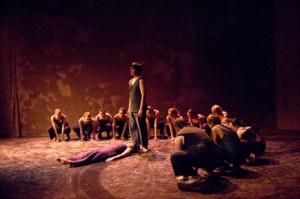 Ever since James Macdonald’s original production of 4.48 Psychosis for the Royal Court in 2000, Kane’s last play has generally been put on with three performers on stage, incorporating the ‘[v]ictim. Perpetrator [and the] [b]ystander’ (4.48: 231) as “characters”. Apart from Daniel Goldman’s production for the Old Red Lion theatre in 2006, there hasn’t been a production of 4.48 Psychosis with a cast of more than 3 people to date, and in contemporary German speaking theatre, there is also a tendency to stage the play as a monologue with the occasional actor impersonating the psychologist only. What these stagings have in common is that they are ideal for a smaller cast and the often tight budget of small to middle-scale theatres and companies. When it comes to exploring the possibilities of Kane’s admittedly intense text, however, I have always felt that a smaller cast falls short of expressing the raw immediacy of Kane’s last play. In my opinion, the poetic images of 4.48 are just as strong as the ones that can be found in Kane’s earlier work and staging these can be as much of a challenge as staging the impossible stage directions in her earlier plays.
Ever since James Macdonald’s original production of 4.48 Psychosis for the Royal Court in 2000, Kane’s last play has generally been put on with three performers on stage, incorporating the ‘[v]ictim. Perpetrator [and the] [b]ystander’ (4.48: 231) as “characters”. Apart from Daniel Goldman’s production for the Old Red Lion theatre in 2006, there hasn’t been a production of 4.48 Psychosis with a cast of more than 3 people to date, and in contemporary German speaking theatre, there is also a tendency to stage the play as a monologue with the occasional actor impersonating the psychologist only. What these stagings have in common is that they are ideal for a smaller cast and the often tight budget of small to middle-scale theatres and companies. When it comes to exploring the possibilities of Kane’s admittedly intense text, however, I have always felt that a smaller cast falls short of expressing the raw immediacy of Kane’s last play. In my opinion, the poetic images of 4.48 are just as strong as the ones that can be found in Kane’s earlier work and staging these can be as much of a challenge as staging the impossible stage directions in her earlier plays.
In September 2007, I was invited to explore these images with a cast of 15 final year drama students by the Department of Theatre, Film and Television Studies at Aberystwyth University. The following is a gathering of impressions relating to the rehearsal process and its often surprising results.
Concept
Every act is a symbol
the weight of which crushes me (226)
Every single one of Kane’s plays shows a clear structure, even where this may not seem apparent right away. She possessed a great sense for detail and a renowned talent for the staging of raw emotions and was convinced that, in the theatre, anything was possible. Yet recent scholarly articles on 4.48 Psychosis and productions of the play took an approach that was very much in keeping with Hans-Thies Lehmann’s understanding of a ‘post-dramatic theatre’. This has always failed to convince me. Both claiming that Kane’s last play was a suicide note and that it was in a sense ‘post-dramatic’ due to its challenging form (no stage directions, no characters, no plot as such) to me always seemed to lessen its artistic impact rather than appreciating it as a well-structured piece of art.
I started with the assumption that what we are witnessing as an audience in 4.48 is the artistic vision of a depressive mind approaching mental breakdown. In this, the lines of the play are structured like the thoughts of the mind in question; their formal realisation on the page indicating delivery just as much as it is marking out the space and time between one respective thought and another. I conceived the image of a mind in turmoil, of different voices struggling to express an illness that was striving to attack the mind as much as the soul itself. In order to achieve this unity of a closed set and the expressiveness of several voices acting as one, my ideas culminated in the staging of a “physical” chorus.
Body
Here am I
and there is my body
dancing on glass (230)
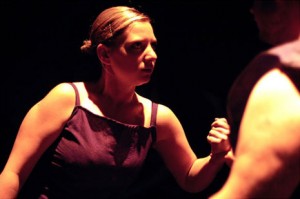 The lines of the play indicate a separation of body and mind which constantly problematises the concept of the self as a whole. As often is the case with pathological depression, the voices portrayed seem to be separated from the body and its physical form. In order to emphasise this separation and its consequences, I decided on a staging that would underline the physicality of the living and breathing body as a contrast to the poetics of the lines. Due to the absence of subtext, I found that the play offers an enormous potential for physical exploration.
The lines of the play indicate a separation of body and mind which constantly problematises the concept of the self as a whole. As often is the case with pathological depression, the voices portrayed seem to be separated from the body and its physical form. In order to emphasise this separation and its consequences, I decided on a staging that would underline the physicality of the living and breathing body as a contrast to the poetics of the lines. Due to the absence of subtext, I found that the play offers an enormous potential for physical exploration.
Working with a cast of fifteen actors opened up a whole new world of possibilities. Inspired by an eastern European theatre tradition, I worked with physical expressions of emotions to support the lines rather than trusting their vocal delivery only. A text as powerful as this, I felt, could only lose when staged in the”talking heads” tradition so prominent on the western European stage. What my approach resulted in, thus, was a challenging physical training for the cast which helped the actors convey emotion before working with the actual lines from a vocal point of view. This, I found, not only made the intention of particular lines clearer and very precise in the end, it also helped the actors fall back on a physical way of expression that could surpass the Stanislavskian background most of them were coming from. As opposed to method or character inspired acting approaches, the physical approach also made it easier for the actors to channel Kane’s raw emotions instead of getting too overwhelmed by their relentless immediacy.
Space
Hatch opens
Stark light (225, 230 and 239)
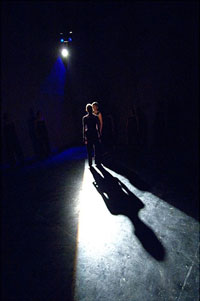 The concept of an audience watching an actual mind in turmoil made me realise that the setting as such was of great importance to the overall success of the production. From an early stage, I initiated several thoughts on angles and geometric patterns that would convey a claustrophobic atmosphere without compromising the actors’ space. I eventually decided to use Libeskind’s architectural plans for the Holocaust Tower in the Jewish Museum in Berlin as an inspiration and the production’s scenographer, Sinead Cormack, designed a set of angles that would make the audience experience the show differently according to which seats they chose to sit in. In the end, the stage was surrounded by five meter high concrete walls which added a genuinely claustrophobic atmosphere without taking away too much space.
The concept of an audience watching an actual mind in turmoil made me realise that the setting as such was of great importance to the overall success of the production. From an early stage, I initiated several thoughts on angles and geometric patterns that would convey a claustrophobic atmosphere without compromising the actors’ space. I eventually decided to use Libeskind’s architectural plans for the Holocaust Tower in the Jewish Museum in Berlin as an inspiration and the production’s scenographer, Sinead Cormack, designed a set of angles that would make the audience experience the show differently according to which seats they chose to sit in. In the end, the stage was surrounded by five meter high concrete walls which added a genuinely claustrophobic atmosphere without taking away too much space.
This idea was also in keeping with initial lighting ideas. Ali Sim’s simple yet effective lighting design underlined the overwhelming height of the walls without shifting the focus from performers to set. My initial specifications regarding the colour and intensity of the lights were met perfectly with a mixture of amber and blue shades for general covering purposes. The play’s recurrent line ‘hatch opens/ stark light’ also required a bright lantern from a top corner of the space that would place the outside world out of reach of actors and audience alike, thereby adding to the hermetic character of the production.
Voice
watch me vanish
watch me
vanish (244)
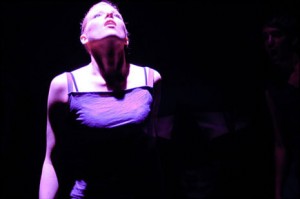 In keeping with traditional ideas of the chorus as being both body and voice, I sought to base the lines of the play on a solid foundation of challenging movement and breath which would allow for a whole range of intensity levels. Although several lines were given out to individual actors, these were always embedded in a general scenic structure that very much relied on the physical and vocal presence of the chorus. At no point could the action or the emotional complexity of the scenes be accredited to one individual only. Where individual lines and monologues were given out, this happened in accordance with the surrounding members of the chorus, thus creating the illusion of several contradictory thoughts in one mind. This practical approach to chorus work was influenced by research of such eastern European companies like CHOREA and FARM IN THE CAVE, but can also be found in most contemporary practical research on traditional chorus work.
In keeping with traditional ideas of the chorus as being both body and voice, I sought to base the lines of the play on a solid foundation of challenging movement and breath which would allow for a whole range of intensity levels. Although several lines were given out to individual actors, these were always embedded in a general scenic structure that very much relied on the physical and vocal presence of the chorus. At no point could the action or the emotional complexity of the scenes be accredited to one individual only. Where individual lines and monologues were given out, this happened in accordance with the surrounding members of the chorus, thus creating the illusion of several contradictory thoughts in one mind. This practical approach to chorus work was influenced by research of such eastern European companies like CHOREA and FARM IN THE CAVE, but can also be found in most contemporary practical research on traditional chorus work.
The results of the above were genuinely striking as to the intensity of Kane’s lines. Since the synchronised speaking of the chorus generally signaled at least some kind of unity of thought, the play’s moments of language loss could be acted out far more powerfully as this could ever have been done without the notion of a chorus impersonating different aspects of the one personality. Intensity varied from whispers in the dark to intense and loud chorus work, all the while indicating different shades of emotion expressed in accordance with the spatial indications in Kane’s script. In addition to the challenging movement, it was possible for the actors not only to vocally portray subtle differences in the depressive mind, but also to add intensity to the lines in a way that would allow for a more complete emotional exploration of their contents. Most of the actors found the necessary vocal training for this extremely helpful and most of the cast made huge progress regarding the full use of their vocal potential on stage.
Rehearsal process
Cut out my tongue
tear out my hair
cut off my limbs
but leave me my love (230)
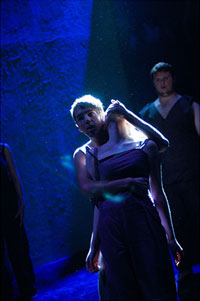 Even though most chorus work requires strong links and a general awareness of each other within the cast, 4.48 was special in that it also required a mutual understanding of and a commitment to the raw emotions and dark humour evident in the text. In order to be able to portray multi-layered feelings, the cast had to find and accept a particular kind of solidarity that would allow for an artistic portrayal of even very intimate emotions such as different shades of despair, anger, hopelessness, loss and longing. Consequently, rehearsals started with a challenging physical session over a period of four full days which was aiming at demolishing personal barriers and anxieties about the other’s body. This physical exploration not only served to awaken physical listening skills in relation to other actors in the space, it also helped generating a special kind of focus and awareness, which would later be incorporated into the synchronised movement exercises of the chorus work.
Even though most chorus work requires strong links and a general awareness of each other within the cast, 4.48 was special in that it also required a mutual understanding of and a commitment to the raw emotions and dark humour evident in the text. In order to be able to portray multi-layered feelings, the cast had to find and accept a particular kind of solidarity that would allow for an artistic portrayal of even very intimate emotions such as different shades of despair, anger, hopelessness, loss and longing. Consequently, rehearsals started with a challenging physical session over a period of four full days which was aiming at demolishing personal barriers and anxieties about the other’s body. This physical exploration not only served to awaken physical listening skills in relation to other actors in the space, it also helped generating a special kind of focus and awareness, which would later be incorporated into the synchronised movement exercises of the chorus work.
Since my understanding of some of the play’s scenes was that they were, in fact, memories or images from the past, I also called sessions with one or two actors at a time in order to work on individual relations. This allowed for very precise work on the abuser-victim relationships so prominent in Kane’s work. These individual sessions especially showed that the physical aspect of the rehearsals also helped the actors build character clues that would later allow them to conjure Kane’s raw emotions by triggering physical movement patterns.
It was evident that some of the emotions the text required would bear hard on the actors, feelings of hopelessness and loss being among the hardest. In order to utilise these emotions as actors, several exercises relating to spatial expression were used to shift the impact of the scenes from actor to audience. Breathing exercises were introduced to assist in channeling emotions rather than playing them off each other.
The range of powerful images I was able to develop with this kind of work never failed to surprise me. Incorporating such abysmal images as the breaking of a neck, the psychological torture of an anonymous victim, and puppet images of a helpless chorus added a particular kind of uneasiness to the production which would otherwise have been lost in a cacophony of voices. The split of a body and a mind in turmoil were illustrated by visceral imagery, the breaking of bonds and the fragmentation of relationships could be staged physically, and the feeling of loss and unreciprocated love was illustrated by distance and the tearing apart of connected bodies.
All of this made for a surprisingly “total theatre” in an Artaudian sense, which I will strive to explore even further in the future.
References
Hope, Christine, Royal Court Education Pack on the Sarah Kane Season (London: Royal Court Theatre, 2000)
Kane, Sarah, Complete Plays (London: Methuen, 2001)
Sierz, Aleks, In-Yer-Face Theatre: British Drama Today (London: Faber and Faber, 2000)
Short Video Documentary: The 4.48 Experience
Credits
All photographs included in this article are the property of Keith Morris. Copyright © 2007 Keith Morris, All Rights Reserved.

Pourriez-vous prendre position sur les conseils à domicile. C’est la première fois que je visite ce site.
It seems like you know very much with regards to this subject and it exhibits with this particular article,
labeled “The 4.48 Experience | Performance Prompt”.
Many thanks -Erwin